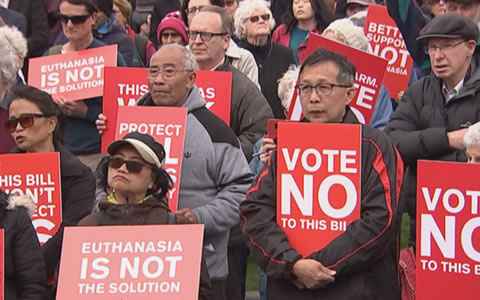A referendum gives everyone the jitters
by Carolyn Moynihan, deputy editor of MercatorNet
The New Zealand Parliament legalised euthanasia this week by 69 votes to 51, pending the outcome of a referendum next year. On paper, The End of Life Choice Act 2017 looks restrictive. Its architect, libertarian MP David Seymour, claims it permits “one of the most conservative assisted dying regimes in the world.”
Opponents say it is full of loopholes, which would make it like every other piece of euthanasia legislation in the world. Indications are that, once such a law is in place, nobody much cares about how it is working.
As National MP Chris Penk said at the final debate: “The question is not whether some people will die in the way the bill allows, but whether many people could die in a way that the law does not allow.” That is what has happened in the Netherlands and Belgium.
Hospices won’t be exempt
The Act allows assisted suicide by a lethal dose of drugs, either self-administered or administered by a doctor or a nurse practitioner. This option would be available to New Zealand citizens or permanent residents aged 18 and over who have been diagnosed as terminally ill and having less than six months to live.
Originally, the Act also covered people with “grievous and irremediable” conditions, which could apply to depressed and disabled persons, but this was dropped by Seymour to garner more support from MPs.
Conscience protection for doctors and nurses was added. They are not obliged to participate in any part of the assisted dying process or suffer any penalties for opting out. However, an attending practitioner with a conscientious objection must tell a patient that they have a right to ask the group administering the scheme for the name and contact details of a replacement doctor or nurse.
An amendment drafted in consultation with Hospice New Zealand that would allow organisations to opt out without risking losing public funding was voted down.
Other efforts to address weak provisions concerning safeguards and accountability were shut down in successive debates by members impatient to get the bill passed.
The beautiful-young-woman-with-a-tumour factor
In the end, Seymour got 69 of the 120-member Parliament on his side. However, to get the eight votes of the New Zealand First Party members (led by Deputy Prime Minister Winston Peters) he and supporting MPs had to accept the party’s demand that the Act go to a referendum. It will be one of at least two proposals the public can vote on alongside next year’s general election, the other being the legalisation of recreational cannabis.
It has taken four attempts, starting in 1995, to get euthanasia across the line in the New Zealand Parliament. Its success this time is in keeping with social trends such as secularisation, but also owes a lot to the advocacy of Wellington lawyer Lecretia Seales, who died of brain cancer in 2015. As an attractive, clever 42-year-old tragically facing death, she has done for euthanasia in this country what another beautiful young woman with a brain tumour, Brittany Maynard, did for the cause in California.
Ms Seales, who had worked for the liberal-minded Law Commission, applied to the New Zealand High Court for a declaration that she had a “right” to assisted suicide under the NZ Bill of Rights Act. She failed at court, but succeeded in the public domain where the support of her husband and family and influential figures such as former Law Commission chief Sir Geoffrey Palmer – not to mention massive and sympathetic media attention – emboldened politicians to have another go at legalising euthanasia. Seales died peacefully of natural causes in June 2015 and in October Seymour lodged his member’s bill. In December that year the New Zealand Herald declared Lecretia Seales “New Zealander of the Year”.
Tens of thousands of opposing public submissions binned
The Seymour bill was drawn from the ballot in June 2017 and had its first reading in December. It then went to a select committee of MPs for study and to receive public submissions. More than 39,000 submissions were received, 90 percent opposing it. Over four months touring the country the committee heard over 2000 oral submissions, of which 85 percent were opposed. These included the majority of medical associations and individual doctors and nurses who addressed the committee.
In addition, a grassroots effort saw published a number of excellent video testimonies from people who had faced a terminal diagnosis or lived with a severe disability, as well as professional commentary on the issue. One of the people appearing in these videos, Clare Freeman, who became tetraplegic at 17 and attempted suicide, addressed hundreds of opponents in front of Parliament on Wednesday as MPs prepared for the final vote. She recounted how a psychiatrist suggested that she could get help to end her life overseas.
All of this has counted for very little with the majority of our political representatives. The public opinion they fear is the referendum looming at the election next year and the debate that will precede it. As NZ Herald writer Claire Trevett commented today: “Few MPs will want to take the lead in that debate – for few will want to be defined by it and have it overshadow their campaign.” That is probably truer of those supporting the legislation than those against it.
The “misinformation” spectre
Supporters have already raised the spectre of “misinformation” to ward off inconvenient publicity about euthanasia and the End of Life Choice Act itself. In fact, Minister of Justice Andrew Little (a supporter) is so concerned that the public may be misinformed and misled that he has talked about setting up a unit in the Ministry of Truth – sorry, Justice – to monitor advertising campaigns. This applies also to the cannabis referendum.
Following an interview with Little, however, the NZ Herald reports, “Teams in the Justice Ministry will prepare neutral, factual information for each referendum and make that publicly available, but they will not be tasked with calling out misinformation.” The Minister expects things to get “ugly” and expects the worst of social media, but has indicated that complaints to the Advertising Standards Authority are the way to go for disgruntled members of the public. He will simply do what he can to “call out misinformation.”
It would be foolish to think that the public is already well informed (and could only be misled by further debate), although politicians and the media regularly invoke opinion polls that show a level of public support for euthanasia of around 70 percent. If the public is generally ignorant, what is the value of a poll that asks a superficial question such as, “Parliament is considering passing a euthanasia law that would allow terminally ill patients to die with the help and approval of their doctors. Would you support it?”
Of course people should be allowed to die. Of course doctors should do what they can to ease their symptoms and reassure them as they die. Aren’t they, don’t they already? Yes. But the euthanasia movement fosters the deceitful idea that people are being kept alive against their will by extraordinary means.
Three-quarters of Kiwis don’t know what ‘choices’ the Act allows
A poll commissioned by Euthanasia-Free NZ and released early this week showed that, despite the legislation being around for four years, the great majority of the public do not know what “choices” the End of Life Choice Act would legalise.
- 74% thought the Bill would make it legal for people to choose to have machines turned off that are keeping them alive, when in fact this is already legal.
- 70% thought it would make it legal for people to choose to not be resuscitated, when people can already ask for such a request to be added to their medical file.
- 75% thought that the Bill made euthanasia available to terminally ill people only as a last resort, after all treatments have been tried to control their pain.
“However, the Bill does not require an eligible person to have tried any pain relief or palliative care before requesting a lethal dose, or to have a consultation with a palliative care or pain specialist to find out what options are available to them,” says Euthanasia-Free NZ.
Like the Act’s supporters. this group is concerned about the referendum. “We doubt that another year would be long enough to allow the public to become adequately informed about the Bill’s content, amid contentious debates on cannabis and the general election,” says its executive officer Renee Joubert. “We are concerned that a referendum result may not reflect the public’s true sentiments.”
There seems, indeed, a real possibility that the cannabis referendum, being a more grass-roots issue (so to speak) and therefore given more media time, will eclipse that of euthanasia. The best we can hope for in any case is a change of government.
Carolyn Moynihan, deputy editor of MercatorNet

This article by Carolyn Moynihan was originally published on MercatorNet under a Creative Commons licence. The original article can be found here.









0 Comments